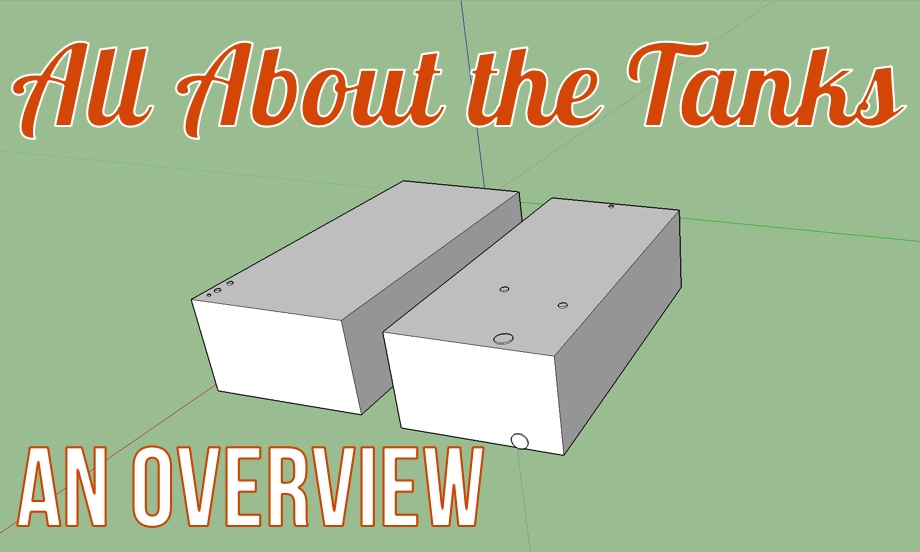When we bought the bus, there was a single 100-gallon waste tank (black and grey combined) down in one of the bays. There was only a small 30-gallon freshwater tank inside the bus in the kitchen cabinets. We knew that we wanted to replace both of the tanks.
We started researching tanks and looking at all of our options. Our goal was to maximize the size of the two tanks in the bay we were designating the “water bay” but also leave room for securing the tanks and all of the additional water components: water pump, water heater, water filters, outdoor shower, valves, inlets, etc.


We made some preliminary measurements and starting looking around for tanks that would fit.
In our research, we came across plasticwatertanks.com. They have many different styles and sizes of tanks. Luckily, we found a tank that fit our needs well. The nice thing about plasticwatertanks.com is that you have options for your fittings. You can either buy the tank with the standard fittings that they show on their website, or you can buy it without any fittings and make the fittings yourself, or you can choose the third option. You can customize your fittings and plasticwatertanks will put them in for you. That’s the route we chose.
Plasticwatertanks was really easy to work with. They have their own form that you simply draw in the location, size, and type of fittings. We also made our own designs in SketchUp just so we could have some larger scale drawings that gave us a better idea of what they would look like. So, we sent those sketch up drawings to them along with their original form. We emailed back and forth with a lady from plasticwatertanks and they were delivered to our house just a few weeks later.



Okay, let me go into a few details on what we chose. Each tank holds 163 gallons and is made out of ⅜” thick food grade plastic. We decided, like the previous owners, to have only one combined waste tank (black and grey combined). While most RVs have separate grey and black tanks, many in bus conversions have chosen to simplify to one combined tank. We tried to research what the benefits of using two separate tanks would be. The main one seemed to be that you can use the grey water to rinse out the sewer hose after dumping the black tank. We will have a flush out valve at the back of the waste tank to hopefully take care of cleaning things out. The other possible benefit that some have mentioned is the ability to dump grey water on the ground, especially when boondocking for extensive periods of time. We really had to think hard about this and do some research. While information is conflicting on what is and isn’t allowed in terms of dumping grey water, what does seem to be clear is that kitchen water that includes grease and food particles is considered “black water”. While we do plan to do as much boondocking as we can, our water tanks are big at 163 gallons, so we should be able to go quite a while without dumping and refilling if we are careful. In the end, we decided that we would just prefer to have one tank to deal with, keeping the plumbing a little more simple.
On the waste tank, we had plasticwatertanks make five fittings. The first is the 3” toilet drain inlet on top of the tank directly under the toilet. The second is the 3” tank outlet on the very bottom of the side of the tank. On the top, we have two 1.5” inlets: one is for the shower drain, and the other is for the kitchen sink, the bathroom sink, and the laundry drains, as well as the vent. On the top of the tank on the opposite side of the tank outlet, we have a 1” fitting that will be where we can flush water through to clean the tank.


On the fresh water tank, we also had five fittings made. On the top, we have two 1” fittings. One will be the city water inlet, and the other is a gravity fill inlet. There is also a ½” fitting for a vent. On the very bottom of the side, we have two ½” fittings that will be the water supply outlets. One will go to the water pump, and we have the other one for a drain in case we ever need to drain the tank.


Cost: ($1630, $127.14 tax, $395 shipping) - Total of $2052.14 - certainly not the cheapest way to go.
One last note on the tanks. Many RV tanks have tank level sensors inside. We have seen quite a few complaints about this type of sensor, from the sensors being gunked up inside the tanks to the fact that they only show a few levels like ⅓, ⅔, full. We have decided on using the SeeLevel sensors. They are mounted on the outside of the tank so they can’t get gunked up. Also, they show percentage full instead of just a couple of fractions.
We are really happy with the new tanks, and hopefully, they will serve us well for years to come. We are busy getting them all secured into the bus so that we can begin the rest of the plumbing.
Watch the video:
Click here If you cannot see the video.





0 Comments
Comments powered by Disqus